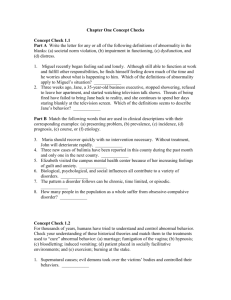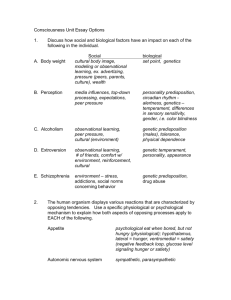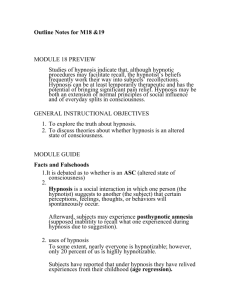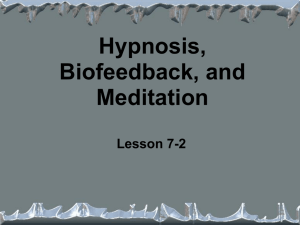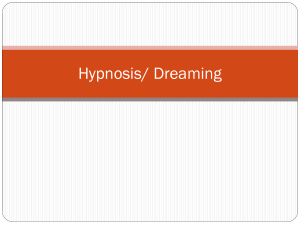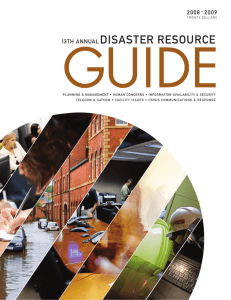Thalia Wheatley Interview: Social Neuroscience & Hypnosis
advertisement
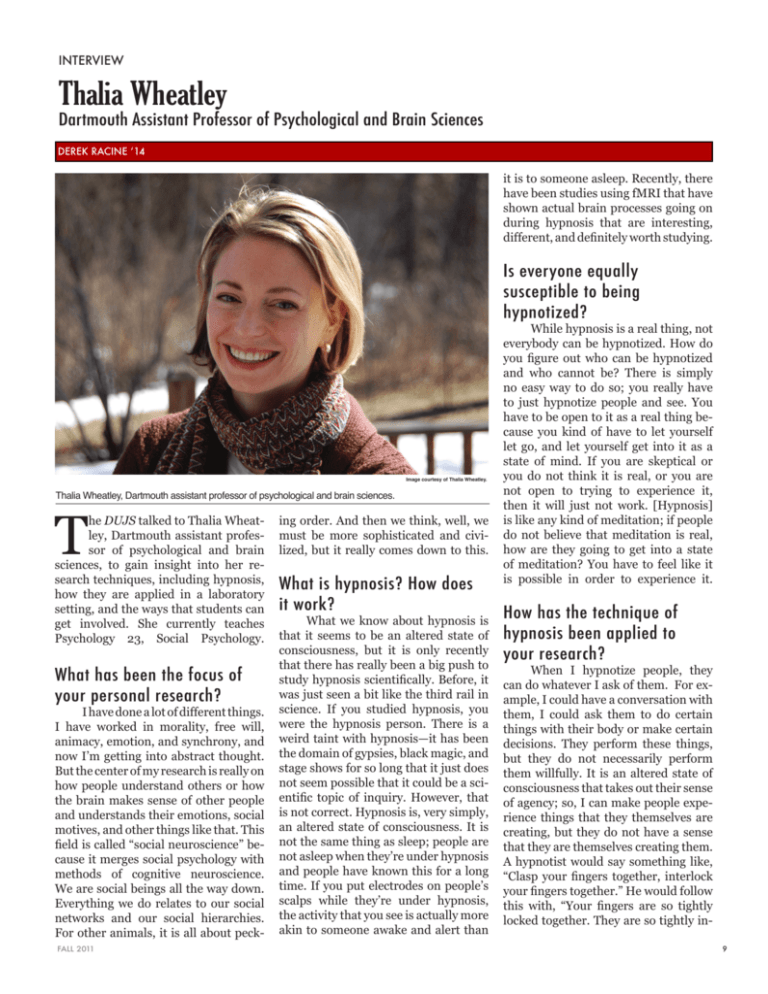
Interview Thalia Wheatley Dartmouth Assistant Professor of Psychological and Brain Sciences Derek Racine ‘14 it is to someone asleep. Recently, there have been studies using fMRI that have shown actual brain processes going on during hypnosis that are interesting, different, and definitely worth studying. Is everyone equally susceptible to being hypnotized? Image courtesy of Thalia Wheatley. Thalia Wheatley, Dartmouth assistant professor of psychological and brain sciences. T he DUJS talked to Thalia Wheatley, Dartmouth assistant professor of psychological and brain sciences, to gain insight into her research techniques, including hypnosis, how they are applied in a laboratory setting, and the ways that students can get involved. She currently teaches Psychology 23, Social Psychology. What has been the focus of your personal research? I have done a lot of different things. I have worked in morality, free will, animacy, emotion, and synchrony, and now I’m getting into abstract thought. But the center of my research is really on how people understand others or how the brain makes sense of other people and understands their emotions, social motives, and other things like that. This field is called “social neuroscience” because it merges social psychology with methods of cognitive neuroscience. We are social beings all the way down. Everything we do relates to our social networks and our social hierarchies. For other animals, it is all about peckFALL 2011 ing order. And then we think, well, we must be more sophisticated and civilized, but it really comes down to this. What is hypnosis? How does it work? What we know about hypnosis is that it seems to be an altered state of consciousness, but it is only recently that there has really been a big push to study hypnosis scientifically. Before, it was just seen a bit like the third rail in science. If you studied hypnosis, you were the hypnosis person. There is a weird taint with hypnosis—it has been the domain of gypsies, black magic, and stage shows for so long that it just does not seem possible that it could be a scientific topic of inquiry. However, that is not correct. Hypnosis is, very simply, an altered state of consciousness. It is not the same thing as sleep; people are not asleep when they’re under hypnosis and people have known this for a long time. If you put electrodes on people’s scalps while they’re under hypnosis, the activity that you see is actually more akin to someone awake and alert than While hypnosis is a real thing, not everybody can be hypnotized. How do you figure out who can be hypnotized and who cannot be? There is simply no easy way to do so; you really have to just hypnotize people and see. You have to be open to it as a real thing because you kind of have to let yourself let go, and let yourself get into it as a state of mind. If you are skeptical or you do not think it is real, or you are not open to trying to experience it, then it will just not work. [Hypnosis] is like any kind of meditation; if people do not believe that meditation is real, how are they going to get into a state of meditation? You have to feel like it is possible in order to experience it. How has the technique of hypnosis been applied to your research? When I hypnotize people, they can do whatever I ask of them. For example, I could have a conversation with them, I could ask them to do certain things with their body or make certain decisions. They perform these things, but they do not necessarily perform them willfully. It is an altered state of consciousness that takes out their sense of agency; so, I can make people experience things that they themselves are creating, but they do not have a sense that they are themselves creating them. A hypnotist would say something like, “Clasp your fingers together, interlock your fingers together.” He would follow this with, “Your fingers are so tightly locked together. They are so tightly in9 terlocked that you can’t take them apart. You would like to take them apart but you cannot because they’re just locked in place.” You will see people actively struggling and squirming, with strain on their faces trying to take their hands apart to no avail. The hypnotist creates this state of mind, but the volunteer cannot recognize the situation. It is an interesting state where people can do all sorts of things, but not necessarily feel agency for what they’re doing. Regarding your work on animacy, could you describe what the mirror system is and how it contributes to our social understanding of movement? There are regions of the brain where people suggest there might be these things called mirror neurons, but we are not completely certain. Mirror neurons are typically found in monkeys, but there are regions of the human brain that respond the same way to how you behave as to how I behave. They have mirror properties in the sense that they respond to action in general and help us understand action. I have done a little bit of work with them in terms of how people move to express emotion, as well as the way we express emotion in music, or any kind of dynamic stimulus that might express some social information. How do you assess how people react while undergoing these different social interactions, or do you use monkeys as a model? The way we tend to assess that at Dartmouth is with functional magnetic resonance imaging (fMRI). As to your other question though, there’s a difference between humans and monkeys, so some of the really high-level social understanding and social interactions cannot be assessed using monkeys. Humans are the right species to study sophisticated social intelligence. With respect to your study of consciousness, how do you think the development of this experience might have contributed to our survival as a species? Do you think other animals also experience consciousness? As far as I know, we are the only species that can really contemplate our own mortality and have a “50,000-foot view” of our lives and plan for the future in that kind of sense. Because we can see our lives stretch out ahead of us and see our death looming in the future, I think it is necessary to develop this sense of self and will to kind of cope with these things. I think other animals have experience but we seem to have this other ability, a “meta-consciousness,” to think about our thoughts. We consider not just our experiences, but also what’s happening to us in the present, and, as a result, we plan in different ways. Concerning your research on morality, do you believe that all humans are innately moral by some standard? I think the belief that you are a free conscious agent making your own choices is critical. The belief of “What’s the point of life if I am just sort an observer of my actions and I’m not deciding anything,” would make things seem hopeless. There is evidence that people find others’ distress aversive, and this causes brain activity associated with aversion to victim distress. I think that is just true of all healthy human brains. These things are just biologically innate to us; we experience strong dislikes of certain things that are bad, even if they are bad just for others. Certainly, within our communities, it would have been evolutionarily advantageous to support each other. A more recent example is in the trench warfare of World War I, between the English and the Germans, where they had to keep moving the troops along the front lines because they would set up these cooperations across; a German solider would fire over the heads of the English soldiers on the other side just to say, “Look! I could kill you if I wanted to, but I don’t want to, so I’m going to shoot over you.” They would keep doing this to each other, using up the artillery without actually killing any soldiers on the other side. These spontaneous cooperative alliances formed; thus, the generals would have to keep moving the troops in an effort to try and break this spontaneous cooperation. Image retrieved from http://upload.wikimedia.org/wikipedia/commons/5/5c/Varian4T.jpg (Accessed 29 October 2011). Functional magnetic resonance imaging is a recently developed way to measure neural activity. 10 Dartmouth Undergraduate Journal of Science What did your career path consist of and how did you arrive at Dartmouth? First, I will say that I love my job and I cannot imagine doing anything else. I think it is an embarrassment of riches to be able to come in and think, “Oh, wouldn’t it be interesting if people do this?” or “I wonder why people do that?” From that, I design some studies, go downstairs, and put some people in a scanner to see what happens to their brains when they interact with each other. It is just fantastic. That said, getting here from college took a really long time and a lot of dedication. It is difficult. When I was an undergraduate, I was actually a political science major. I took an introduction to social psychology course as an elective because it sounded easy. I planned to take this course and get my degree in three years, but I loved social psychology and realized that I wanted to do it for the rest of my life. I started working in a research lab, applied to graduate school in social psychology, entered a social psychology Ph.D. program, and spent the next seven years there. It was kind of a crazy time, but I loved it so much. Most people take five years, which is still a long time. In today’s FALL 2011 world of psychology or neuroscience, after the five years necessary to get a Ph.D., you have to have a post-doctoral experience if you want to do research. This involves going somewhere else for two to five years for further training in imaging, behavioral methods, etc. Then, you go on the job market, hopefully with an assistant professorship, followed by six or seven years on tenure track; eventually you come up for tenure, and that is when people decide whether or not you get to actually stay in your job or not. I am forty and about to come up for tenure. It has been a long, tough road, but it is my life and I love it. What would be your advice to someone interested in scientific research in the psychological and brain sciences? hours a week, and they run studies. We brainstorm at lab meetings. They do all sorts of different things. Oftentimes, I will get them in as freshmen and they will end up staying all four years, and they will even do honors theses in their senior year. It is the best sort of experience you can have for what graduate school would really be like. Then, when it comes time for you to write your application for graduate school, [admissions committees] look at potential graduate students [to see] if they really know what life is like as a researcher— have they been in a lab, do they have letters of recommendation from people who say “this person has been in my lab for a year or two, they are excellent, this is what they have done, they are committed…” and so forth. So, that’s my best advice: get into a lab. If students are interested in psychology as undergraduates and they think they might want to go to graduate school, then get into a lab. That is my best advice—get into a lab and get into a lab as soon as you can. Even if you are a senior and you are just figuring it out, try to get into a lab. I have research assistants in my lab that work about ten 11


